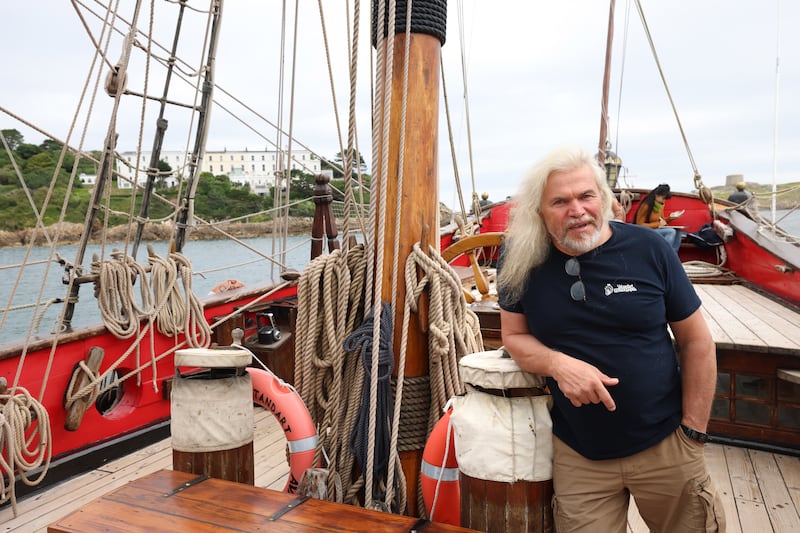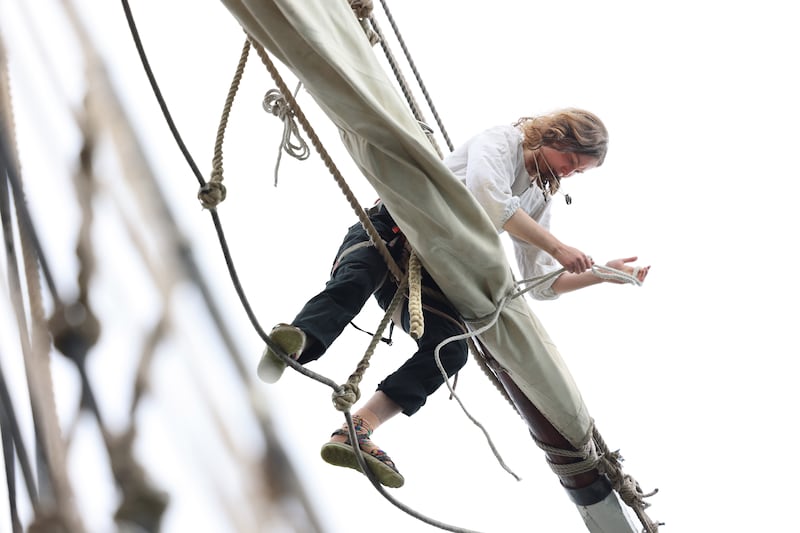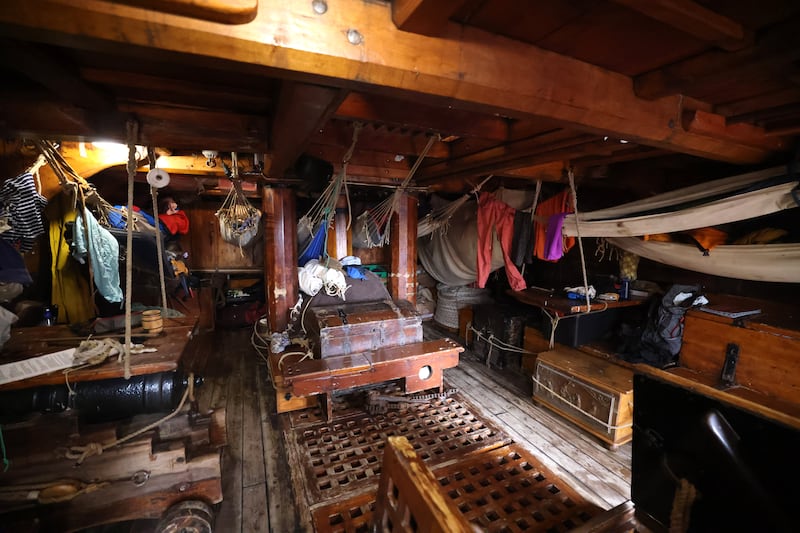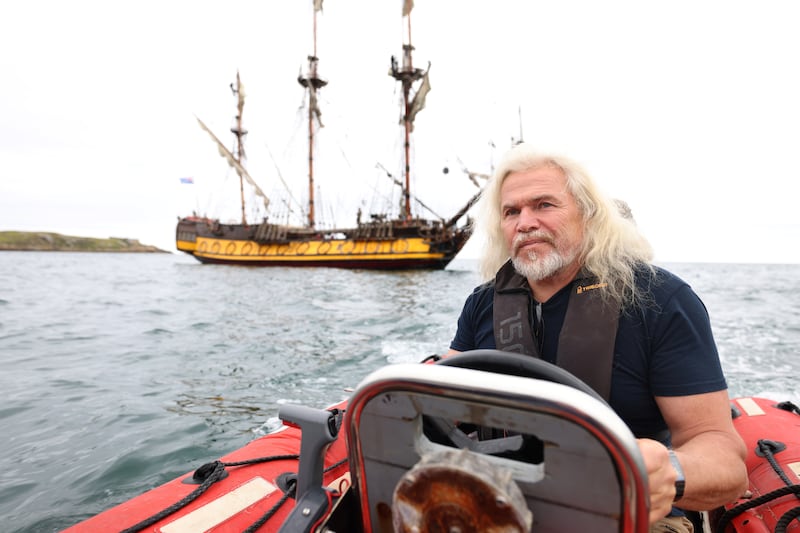With his unkempt, sea-blown hair, barrel chest and bare feet, captain Vladimir Martus looks every inch the grizzled mariner as he stands at the helm of the Shtandart, which spent the last two days anchored in Killiney Bay.
His appearance is well earned. The Shtandart, an exact replica of the first flagship of the Russian navy which was constructed by tsar Peter the Great in 1703, has only docked at port a handful of times in the last year.
This is not by choice. When Russia invaded Ukraine in February 2022, the Shtandart was a Russian-flagged ship and thus fell under subsequent EU sanctions, preventing it from doing business with member states or docking in their ports.
Martus, from St Petersburg in Russia, attempted to rectify this in 2024 by reflagging the ship with that of the Cook Islands. However, in June 2024 the European Commission amended its sanctions to include “replicas of historical ships” that were flagged as Russian at the time of the invasion.
READ MORE

As a result, the Shtandart had been refused permission to dock at most EU ports it has visited. Instead, it anchors out at sea while crew and supplies are ferried aboard by dinghy.
It arrived in Killiney Bay off south Dublin on Monday, having sailed from La Rochelle and Saint-Malo in France where it had been denied permission to dock.
On Tuesday, curious onlookers gathered along Vico Road to take photos of the strange, anachronistic vessel anchored a few hundred metres from the sea baths.
On board, Martus is exasperated. He rails against accusations the Shtandart is a Russian “propaganda” vessel. It is a training ship, on which international crews learn the art of seafaring, he says.
He pulls up a copy of the crew manifest. Six are from Russia, while the rest of the 16 members are from all over the world, including the UK, China, Japan and the US. Most the crew appear young and inexperienced. They range in age from 18 to 75, Martus explains.
Conditions on board the ship are basic and cramped, all in the name of authenticity. The anchor and helm are operated by ropes, just like on the original, while the crew sleep cheek-by-jowl in hammocks below deck. Iron cannons line the deck.
There are just a few concessions to modernity. Unlike the sailors of Peter the Great, they have on-board toilets and a flat-screen television in the galley.
Martus says he built the Shtandart, which launched in St Petersburg in 1999, with his own hands. “I cut down the trees myself,” he says.
The ship is undoubtedly a symbol of Russian naval strength. But Martus argues it is more symbolic of the links between Russia and Europe.
The original was copied directly from a Dutch ship commissioned by William of Orange and was part of Peter the Great’s efforts to open up his empire to European influences (Martus does concede, however, that the original Shtandart was also used against Sweden in the Great Northern War).



“We do not support Putin,” he says, adding that he is against the war in Ukraine. His father was from Ukraine and he has a cousin fighting with the Ukrainian armed forces.
The house of his aunt and uncle in Donetsk was recently hit by a Russian missile, he says.
The captain alleges individuals have been running a “campaign” against the ship and creating a distorted picture of its purpose in EU countries.
The “No Shtandart in Europe” campaign presents a different picture of the ship and its captain. It has accused Martus of violating maritime law and has called on the Irish authorities to ban the vessel from its waters entirely.
“Subsequently, if the Shtandart continues to access prohibited waters and ports, Vladimir Martus should be arrested and expelled to Russia,” the campaign said.
Martus says he has not bothered to seek permission to dock in Dublin, as he knows it will be denied.
The ship’s next stop is Aberdeen but it may have to stop somewhere in Ireland along the way to take on fresh drinking water, he says. He hopes this will be permitted for humanitarian reasons. The ship also has to get rid of a significant amount of rubbish.
On Tuesday morning, the Shtandart was hailed by the Irish Naval Service ship LÉ Aoibhinn. Martus was interrogated about his intentions. “We had half an hour radio communication. They were very friendly and wished us well,” he says.
In response to queries, the Department of Transport, which regulates marine traffic, said it is aware of the Shtandart’s arrival off south Dublin. It said that, according to information from third party sources, the ship is registered under a Russian flag and is therefore likely to be subject to sanctions.
A department spokesman said it has contacted all east coast ports under its remit to “ensure appropriate measures are taken”.
Martus has two court cases pending in Europe against the sanctions regime, which he argues does not apply to wooden vessels. He says he is worried about the future of the ship. “Either these cases succeed or the war ends; I don’t know.”
Meanwhile, Fine Gael TD for Dún Laoghaire Barry Ward wrote to Timmy Dooley, Minister of State with responsibility for Marine Affairs, calling for the “urgent” removal of the ship from Irish waters.
“The captain of this ship is showing clear disregard for the EU sanctions, and this arrogance and perception of impunity cannot be permitted,” Ward said.
The ship departed Killiney Bay at about 3pm on Tuesday and set sail for Aberdeen in Scotland.
Locals seemed more relaxed about the Shtandart’s presence on Tuesday, with some going out of their way to offer assistance. Martus points to buckets of fresh crabs and lobsters “donated by friendly fisherman”.
One of the ship’s younger crew members, an American man, wore a tweet jacket he had just purchased while ashore. The shop owner had thrown in a cloth cap for free, he says. “I love your country.”
At the Vico Baths, local woman Niamh Wyatt said that on Monday she brought crew members to West Wood gym for hot showers and to a laundromat to clean their clothes.
“They’re lovely,” she says. “I feel bad for them.”
















